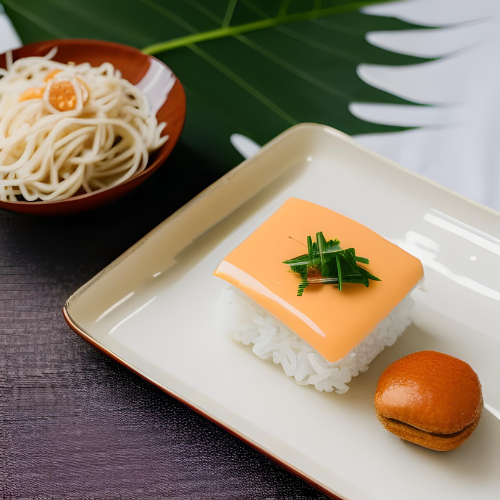When the chill of December winds brushes through the Land of the Rising Sun, a delightful melody resonates in every neighborhood – the rhythmic pounding of the Mochitsuki. Japan’s Mochitsuki tradition, an indispensable part of their New Year celebration, has been preserved and nurtured for centuries. As we journey through this article, we’ll unravel the profound elements that lend this ritual its charm and uniqueness. For the uninitiated, Mochitsuki is a traditional Japanese mochi (rice cake) pounding ceremony. This festive feast is more than just a culinary procedure; it is a testament to the enduring spirit of unity, perseverance, and shared joy that binds the Japanese people together. We’ll delve into the intricate layers of Mochitsuki, from its historical roots to its modern adaptations, its cultural importance, the meticulous process of Mochi-making, and its role in community building. It’s time to embark on this intriguing exploration of Japan’s Mochitsuki tradition!
Historical Roots of Mochitsuki
The history of Mochitsuki, or mochi-pounding, can be traced back to the Yayoi period (300 BC-300 AD), a pivotal era that saw the advent of rice cultivation in Japan. Rice, as a crop, began to hold significant economic and spiritual value in society. The creation of mochi, initially a luxury reserved for religious offerings and aristocratic feasts, required the rice to undergo a transformation – from its mundane form to a divine, symbolically charged delicacy. The method chosen for this transformation was a reflection of Japan’s inherent values – labor-intensive, collaborative, and ritually significant – thus, the tradition of Mochitsuki was born.
In its initial years, Mochitsuki was primarily an autumn event. It was conducted during the harvest season, as a way to offer the newly reaped grains to the Shinto deities, Kami. The freshly made mochi was seen as a divine entity, bridging the gap between humans and their deities. Over time, as Buddhism spread in Japan, mochi came to be used in Buddhist rituals as well. Eventually, during the Heian period (794-1185), Mochitsuki started to gain recognition as a part of the New Year celebrations, owing to the mochi’s symbolism for longevity and well-being.
The historical roots of Mochitsuki are intricately woven into the socio-cultural fabric of Japan. It’s not just a ceremonial act but a time-honored tradition, symbolizing gratitude, community, and reverence towards the divine powers.
The Cultural Significance of Mochitsuki
The cultural impact of Mochitsuki extends beyond just making mochi. It encapsulates a spirit of unity and shared endeavor. During Mochitsuki, individuals come together, work as one, and partake in the joy of creating something meaningful. Every stroke of the wooden mallet, every rotation of the sticky rice in the mortar, resonates with the Japanese principle of ‘Wa,’ or harmony.
Mochitsuki is also deeply intertwined with Japanese spirituality. The white, smooth, and flexible mochi is seen as a symbol of purity, longevity, and resilience. These are values the Japanese people aspire to in their personal lives, which is why Mochitsuki is a tradition not just celebrated, but revered.
During the New Year, ‘Kagami Mochi,’ a specific mochi arrangement, is placed as an offering to the gods. This ritual is a way for people to express their gratitude for the past year and their hopes for the upcoming one. The Kagami Mochi is eventually broken into pieces (not cut, as that symbolizes severing ties) and consumed, signifying the absorption of the gods’ blessings.
Through its symbolic and spiritual significance, Mochitsuki serves as a vivid reflection of Japan’s unique culture and its deep-rooted traditions.
The Meticulous Mochi-Making Process
The process of Mochitsuki is a labor of love and teamwork. It involves several stages, each requiring a distinct skill and the collective effort of the participants.
To start with, a special short-grain glutinous rice, known as ‘mochigome,’ is soaked overnight, then steamed until it’s soft and sticky. Once the rice is properly steamed, it’s transferred to a large mortar, typically made of wood or stone, known as ‘usu.’
Now, the magic of Mochitsuki truly begins. The rice in the usu is pounded with large wooden mallets, ‘kine,’ with a rhythmic harmony that is nothing short of a dance. One person, usually the strongest, swings the mallet high and brings it down forcefully onto the rice, while another, in perfectly timed synchrony, turns and wets the rice between the strikes. The pounding continues until the rice is transformed into a smooth, elastic, and shiny mass – the mochi.
Making mochi in the Mochitsuki style is a significant communal event in Japan. The shared labor, the rhythm of the pounding mallets, and the joy of creating something together all contribute to the sense of unity and camaraderie that is central to Mochitsuki.
The Role of Mochitsuki in Community Building
Mochitsuki isn’t just a process of making a food item, it’s an event that fosters community bonds and builds stronger relationships. In the olden days, every neighborhood in Japan had a communal ‘usu’ and ‘kine.’ Families would gather around it to pound their rice into mochi. The elderly, the adults, and the children, everyone had a role to play. Some would help in steaming the rice, some would take turns in pounding, while others packed the finished mochi. These communal Mochitsuki gatherings were not just about physical labor; they were also about sharing stories, passing down traditions, and simply enjoying each other’s company.
In the modern world, with the advent of mochi-making machines, Mochitsuki gatherings have become less common. But many communities and families still choose to carry on with the tradition, not just for the sake of making mochi, but for the invaluable bonding time it provides.
Even today, in Japanese diaspora communities around the world, Mochitsuki events serve as a bridge that connects them to their roots and allows them to share their rich cultural heritage with the younger generation.
The Flavorful World of Mochi Varieties
Once the mochi is made, it opens up a myriad of culinary possibilities. The beauty of mochi lies in its versatility – it can be savory, it can be sweet, and it can be anything in between.
Sweet mochi, known as ‘daifuku,’ is a popular choice. Soft mochi is filled with sweetened red bean paste and dusted with potato starch to prevent it from sticking. ‘Ichigo Daifuku’ takes it a step further by adding a whole strawberry inside the mochi, creating a burst of fruity freshness with every bite.
Savory mochi dishes are equally delightful. ‘Zoni’ is a traditional New Year’s soup with vegetables, meat, and chewy mochi pieces. It is often the first breakfast of the New Year in Japan. Another variant, ‘Yaki Mochi,’ involves grilling the mochi until it’s crispy on the outside but remains soft on the inside. It’s typically served with soy sauce and wrapped in seaweed.
The range of mochi variations signifies how Japan’s Mochitsuki tradition transcends from a simple rice-pounding event to a gastronomic journey, offering a world of flavors that pleases every palate.
Health Benefits of Mochi
Mochi is not just a treat for the taste buds, but it also packs numerous health benefits. Made from glutinous rice, mochi is naturally gluten-free, making it an excellent choice for those with gluten intolerance or celiac disease.
Furthermore, the rice used in mochi, mochigome, is a good source of complex carbohydrates, which provide sustained energy. This makes mochi an ideal snack for those needing a quick energy boost, be it students studying for exams, athletes before a match, or anyone having a busy day.
Additionally, the process of making mochi by the traditional Mochitsuki method also has its benefits. The physical exertion involved in pounding the rice can be a good workout, and the communal aspect of the event can have positive effects on mental well-being, fostering feelings of belonging and happiness.
Mochitsuki in Contemporary Japan
In contemporary Japan, the tradition of Mochitsuki still thrives, albeit with modern adaptations. While the traditional method of pounding rice in a ‘usu’ with a ‘kine’ is still prevalent, the use of mochi-making machines has become widespread, particularly in urban areas.
Moreover, Mochitsuki events have extended beyond the residential sphere to educational and corporate institutions. Many schools in Japan hold Mochitsuki events as a part of their cultural education. Similarly, corporations host these events as a team-building exercise.
Modern Japan has also seen a rise in creative mochi flavors and designs, ranging from matcha mochi to mochi ice cream, and even mochi donuts! These innovations not only satisfy the evolving palates of the Japanese people but also introduce the rich Mochitsuki tradition to a global audience.
Mochitsuki Around the World
Mochitsuki is not confined to Japan alone. With the global spread of Japanese cuisine and culture, the Mochitsuki tradition has also found its way into various parts of the world.
Japanese diaspora communities often host Mochitsuki events, particularly around the New Year, as a way to connect with their cultural heritage. These events often include demonstrations of the Mochitsuki process, mochi tasting sessions, and other cultural performances.
Additionally, the universal appeal of mochi has led to its widespread availability in supermarkets and food stores around the globe. From mochi ice cream in the US to mochi-filled pastries in France, the Mochitsuki tradition continues to touch people’s lives in different corners of the world.
Mochitsuki and Tourism in Japan
For any food and culture enthusiast visiting Japan, participating in a Mochitsuki event is a must-have experience. Many traditional ryokans (Japanese inns) and cultural centers offer Mochitsuki experiences for their guests. These sessions provide a hands-on opportunity to participate in the Mochitsuki process, make your own mochi, and, of course, savor the fruits of your labor!
Such initiatives promote cultural understanding and provide a unique, immersive way for tourists to engage with Japan’s traditions. Through Mochitsuki, tourists can get a taste of authentic Japan, its cultural richness, and its deeply rooted sense of community.
Preserving the Mochitsuki Tradition
Preserving the Mochitsuki tradition is not just about keeping an old ritual alive; it’s about safeguarding a significant aspect of Japan’s cultural heritage. Despite the modern conveniences of mochi-making machines, many Japanese families and communities continue to uphold the traditional Mochitsuki method.
Schools play a vital role in this preservation effort by introducing children to Mochitsuki and educating them about its cultural importance. Similarly, community-led Mochitsuki events provide a platform for the older generations to pass on their knowledge and experiences to the younger ones.
In the end, Mochitsuki is more than a New Year feast or a mochi-making process; it’s a symbolic thread that weaves together generations of Japanese people, connecting them with their cultural roots and shared identity.
We welcome any suggestions or questions. You can email us or contact us using the contact page.
You can also connect with us on the following social networks:









0 Comments